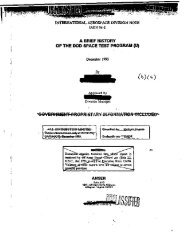LUNAR EXPEDITION PLAN
LUNAR EXPEDITION PLAN
LUNAR EXPEDITION PLAN
Create successful ePaper yourself
Turn your PDF publications into a flip-book with our unique Google optimized e-Paper software.
: AHa<br />
«*<br />
4.e.5-5 DOPPUK RASAS<br />
Anticipation that radio beacons iti.ll be In place on the<br />
lunar surface has somewhat simplified the lunar landing phase of<br />
the mission. She use of mid-course guidance will enable the<br />
vehicle to approach the noon within llne-of-sight of at least<br />
one of the radio beacons, and the beacon can be utillied for<br />
the approach phase of the lunar landing. However, for final<br />
vertical velocity measurement, a sensing technique particularly<br />
sensitive to snail velocity changes Is required. A small CM<br />
doppler radar Is ideally suited for this requirement- Therefore<br />
development of a small, reliable doppler radar which can operate<br />
in the lunar environment is needed. In order to decrease the<br />
power requirement for the radar it should not be required to<br />
operate at a range of over 300 miles.<br />
-1.2.5-6 RE-OHBT amuses<br />
Major emphasis must be placed on the guidance requirements<br />
for the re-entry phase of the lunar mission. Position,<br />
velocity, and attitude can be measured by the inertial system,<br />
however, other measurements initially required will be temperature,<br />
temperature rate, structural loading and air density.<br />
Extensive further study is needed to define these measurements<br />
villi any accuracy. Early earth return equipment Bhould furnish<br />
the data necessary to develop the required re-entry guidance<br />
package for the lunar mission.<br />
*.2.5-7 ADAPTIVE AUTOPILOT<br />
The control of the re-entry vehicle will require an<br />
adaptive autopilot due to the vide variation in surface effectiveness.<br />
Adaptive autopilots such as used In the X-15 are available,<br />
but extensive development is needed to ready them for use in the<br />
lunar mission.<br />
4.2.5-8<br />
TJie following projects or specific tasks within these<br />
projects can be utilized to provide the development required<br />
for the LUNHX program.<br />
klkk (0) Guidance and Sensing Techniques for Advanced<br />
Vehicles<br />
JfOl6"5"ttf) BataTiConversion Techniques<br />
508^5 (U) Guidance Utilizing Stable Timing Oscillators<br />
WMAIHH58<br />
-^.- *




